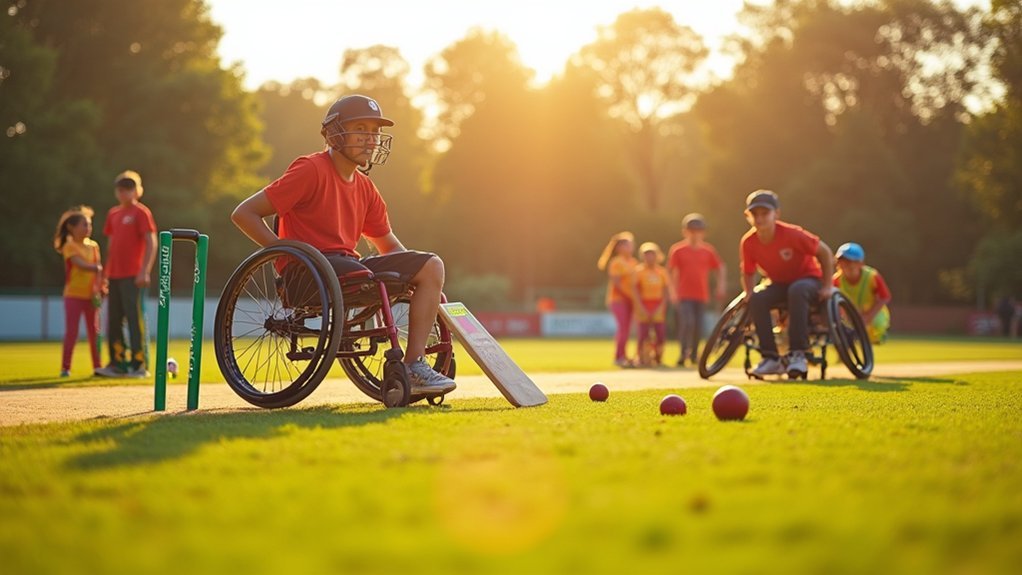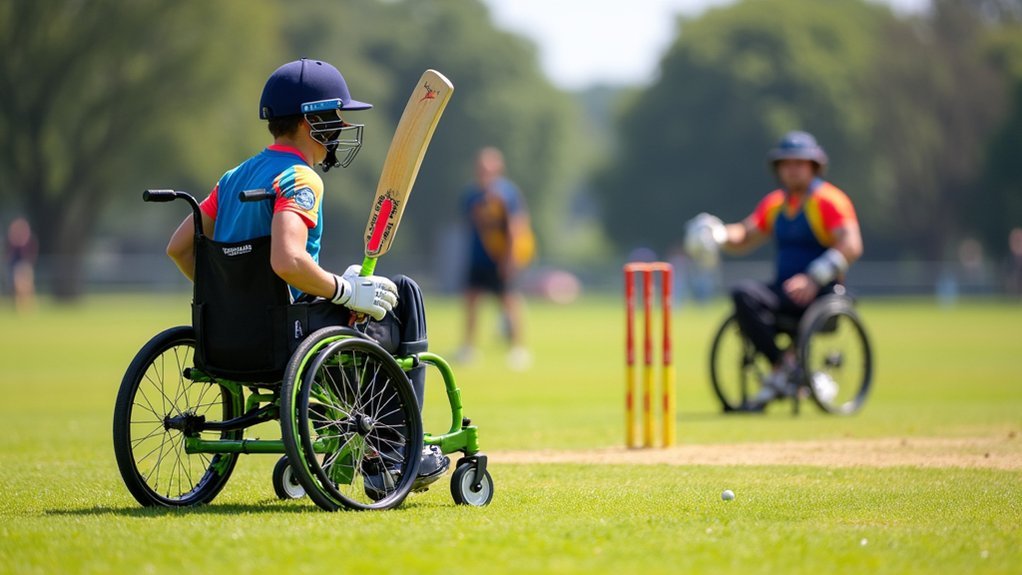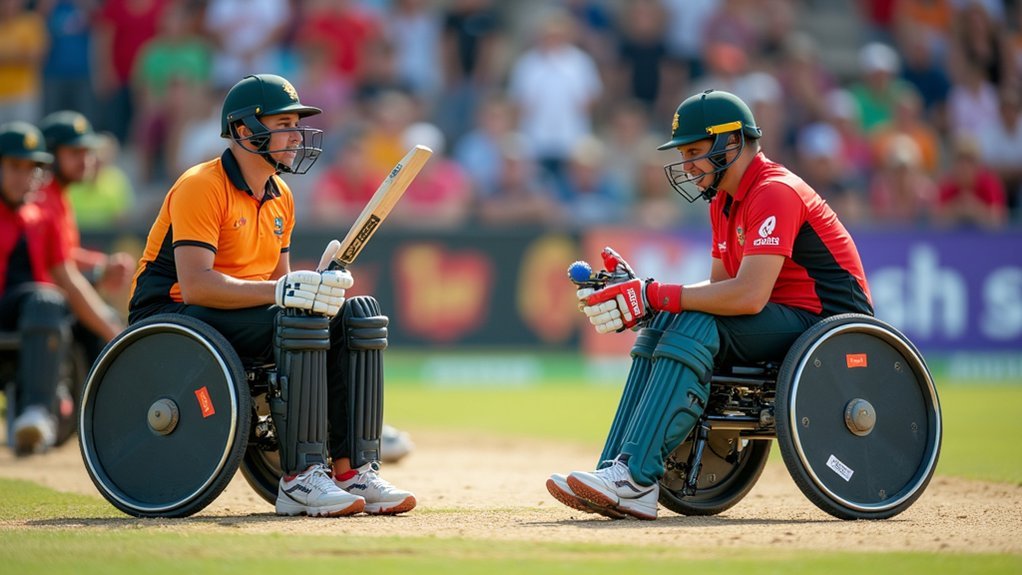Cricket modifications include lighter bats, audible balls, and adjusted rules to accommodate all physical abilities. You’ll find wheelchair-friendly playing surfaces, modified fielding zones, and seated cricket options that maintain competitive elements while ensuring meaningful participation. Visual impairments are addressed through bells in balls and tactile field markers, while sensory adaptations reduce overwhelming stimuli. These thoughtful changes don’t just enable participation—they create pathways to improved health, confidence, and social connection for everyone involved.
Cricket Modifications for All Physical Abilities

When designing cricket activities, accessibility should never be an afterthought but a fundamental consideration. You can create inclusive cricket environments by applying the STEP framework—adjusting Space, Time, Equipment, and People elements to accommodate various physical abilities.
Your cricket training sessions become more accessible when you incorporate specialized equipment like lighter balls and adjustable stumps. Games such as “V Cricket” and “Round the Clock” reduce physical strain while maintaining competitive elements, allowing players to develop skills at their own pace.
Equipment adaptation creates pathways for everyone to experience cricket’s joy while developing fundamental skills at their own pace.
Physical conditioning requirements can be modified through varied pitch lengths and team sizes, ensuring everyone participates meaningfully.
Visual aids and simplified scoring systems further enhance engagement for players with diverse abilities. Remember, effective skill development happens when you tailor the experience to individual needs rather than expecting players to adapt to standard formats.
Understanding Inclusive Cricket: Benefits and Principles
Inclusive cricket transforms lives by creating opportunities for players of all physical abilities to experience the joy and camaraderie of the sport.
You’ll find that well-designed adaptive equipment and modified rules don’t just enable participation—they promote equity and dignity while preserving cricket’s competitive spirit.
Research confirms that players involved in inclusive cricket programs report significant improvements in physical health, mental wellbeing, and social connections, demonstrating the profound impact of accessibility in sports.
Why Inclusion Matters
Because cricket belongs to everyone, the push for inclusive practices represents more than just a trend—it’s a fundamental shift in how we comprehend sports participation.
When you embrace inclusion in cricket, you’re creating pathways for skill development that benefit players across all physical ability levels.
Research confirms that inclusive cricket programs deliver significant benefits:
- Enhanced physical and mental wellbeing – participants experience improved self-esteem and social skills
- Strengthened community engagement – diverse players create vibrant, cohesive cricket communities
- Expanded participation opportunities – adapted formats like visually impaired or wheelchair cricket guarantee everyone can play
Adaptive Design Essentials
Creating truly accessible cricket experiences requires a fundamental understanding of adaptive design principles that go beyond superficial modifications. When you implement inclusive cricket programs, focus on adapting both equipment and environment to accommodate diverse physical abilities.
Modified equipment forms the cornerstone of accessible play—lighter bats and softer balls enable participants with varying strengths to engage confidently. Consider adjusting field dimensions and simplifying rules to match players’ mobility levels while maintaining the sport’s core elements.
Effective adaptive design isn’t just about physical accommodations; it’s about creating an environment where everyone can participate meaningfully. Research confirms these adaptations deliver significant benefits beyond physical exercise—they foster community connections and improve mental wellbeing.
Your inclusive cricket program should balance competitive elements with accessibility, ensuring all players experience the joy and camaraderie of cricket regardless of their limitations.
Social Impact Evidence
Research consistently demonstrates that adaptive cricket programs generate profound social benefits that extend far beyond the playing field.
When you participate in inclusive sports like cricket, you’ll experience significant improvements in mental well-being, with players reporting enhanced confidence and expanded social networks.
- Mental health benefits – Participants develop stronger self-esteem and reduced anxiety through the supportive team environment that values diverse capabilities.
- Physical fitness improvements – Evidence shows measurable gains in motor skills and overall health, helping reduce obesity-related conditions regardless of ability level.
- Community cohesion – Equal opportunities in cricket foster meaningful connections across diverse groups, breaking down social barriers.
These impacts highlight why adaptive cricket isn’t just about sport—it’s about creating accessible pathways to wellbeing for everyone.
Modified Equipment for Enhanced Accessibility
You’ll find cricket more accessible with specially designed bats that match your grip strength and physical capabilities, whether you need a lightweight model or one with enhanced grip features.
Adaptive balls ranging from softer compositions to varied weights (4oz to 9oz) can accommodate your specific needs while still maintaining the game’s core challenges.
Inclusive protective gear, designed with adjustable features and improved comfort, guarantees you can participate safely regardless of physical limitations.
Adaptive Bats and Balls
While traditional cricket equipment can present barriers for players with different physical abilities, adaptive bats and balls have revolutionized inclusive play.
You’ll find equipment designed specifically to support your unique needs, ensuring everyone can participate in cricket regardless of mobility or strength limitations.
- Varying bat weights and grip sizes provide better control and easier handling, allowing you to select equipment that matches your physical abilities.
- Softer, brightly colored balls enhance visibility for players with visual impairments while reducing injury risk for those with limited mobility.
- Oversized or lightweight equipment options help you build confidence and develop cricket skills safely, removing barriers that standard gear might present.
These adaptive modifications make inclusive cricket accessible without compromising the fundamental joy and competition of the game.
Inclusive Protective Gear
Safety on the cricket field shouldn’t exclude anyone based on physical ability, which is why inclusive protective gear has become vital for truly accessible cricket.
You’ll find specialized helmets featuring adjustable straps and padded interiors that accommodate different head shapes while maintaining critical visibility during play.
Customizable batting pads now address diverse leg sizes and shapes, guaranteeing better movement and reducing injury risk for all players.
The ergonomic designs in modern cricket gloves include varying grip textures that help players with limited hand strength maintain proper bat control and confidence.
Manufacturers increasingly use lightweight materials across protective equipment, creating flexible gear that enhances mobility for players with physical disabilities.
These thoughtful modifications guarantee that safety equipment protects effectively while allowing everyone to participate actively in the sport they love.
Adapted Rules for Players With Mobility Challenges

To guarantee cricket remains accessible to everyone regardless of physical ability, numerous modifications have been implemented for players with mobility challenges.
Cricket’s inclusivity mission ensures all players can participate, regardless of mobility limitations, through thoughtful adaptations.
These adapted rules foster inclusivity while preserving cricket’s competitive spirit, allowing participants to enjoy the game regardless of mobility limitations.
You’ll find several equipment and rule adjustments that make cricket more accessible:
- Wheelchair-friendly playing surfaces with modified fielding zones that let you participate effectively without extensive movement.
- Lighter bats and softer balls that improve your control while reducing injury risk.
- Adjusted scoring systems that reward your participation and effort rather than traditional performance metrics.
These adaptations also include shorter game durations and more frequent rest periods, ensuring you can comfortably engage throughout the entire match.
Visual Impairment Adaptations: Auditory Cricket
Since vision typically plays a crucial role in cricket, innovative adaptations have transformed the game into an accessible, sound-based experience for visually impaired players. The modified version uses a special ball containing bells, allowing participants to track its movement through auditory cues rather than sight.
You’ll find the playing field has adjusted dimensions, complemented by tactile markers that help players understand their surroundings. Guides or coaches provide verbal instructions during gameplay, enhancing navigation and positioning awareness.
The rules embrace inclusivity by allowing players to run based on sound rather than visual feedback. This adaptation has gained significant traction globally, with organizations establishing dedicated programs that foster competition among visually impaired athletes at national and international levels.
This demonstrates cricket’s remarkable versatility as a truly inclusive sport.
Seated Cricket: Techniques and Implementation

To equip your seated cricket program properly, you’ll need adaptable stumps, lightweight balls, and specialized bats with extended handles for enhanced reach and control.
When teaching modified bowling techniques, focus on upper body rotation, controlled release points, and accuracy rather than speed to maintain competitive gameplay while accommodating players’ mobility limitations.
You can adjust the scoring system by rewarding technical skill execution, implementing boundary advantages for players with severe mobility restrictions, and creating classification tiers that guarantee fair competition across different ability levels.
Essential Equipment Adaptations
Because player comfort and accessibility drive successful seated cricket programs, equipment adaptations become the foundation for inclusive participation. When implementing adapted cricket, you’ll need specialized tools that support proper batting techniques while accommodating seated players.
- Modified cricket bats – Lightweight, smaller bats allow for easier handling and better control when batting from a seated position.
- Adaptive stumps – Lower-to-ground stumps provide appropriate targets for seated players, enhancing skill development.
- Comfortable seating options – Adjustable chairs guarantee proper posture during play, critical for effective swing mechanics.
You’ll also benefit from softer balls that maintain safety while providing a realistic gameplay experience.
Consider incorporating ramps or rollers for ball delivery, eliminating running requirements while keeping focus on equipment modifications that maximize participation and enjoyment for players with physical disabilities.
Modified Bowling Techniques
Proper equipment adaptations set the stage for effective gameplay, and nowhere is this more apparent than in bowling techniques for seated cricket players. Through adapted traditional bowling methods, players with limited mobility can fully participate in matches with dignity and competitiveness.
You’ll find that seated bowlers typically use underarm or modified overarm deliveries, focusing on accuracy rather than speed. A bowling ramp can help you deliver the ball at appropriate heights for batsmen, ensuring fair competition.
To improve your seated bowling technique, work on developing core stability and upper body strength through specialized drills. These exercises enhance your delivery precision and consistency.
Matches can incorporate modified rules, including adjusted pitch lengths or over counts, maintaining cricket’s essence while accommodating diverse abilities. This balanced approach keeps the sport challenging and engaging for all participants.
Scoring System Adjustments
While traditional cricket scoring provides a solid foundation, seated cricket thrives with strategic adjustments that reward technique and adaptability. Your scoring system can incentivize skill development while making the game more engaging for players of all abilities.
- Boundary bonuses – Award extra points for shots that cross boundaries while maintaining proper seated technique, encouraging strategic play that combines power and precision.
- Tiered scoring – Implement different point values based on shot difficulty, motivating players to attempt more challenging maneuvers and develop their skills.
- Teamwork multipliers – Grant additional runs for collaborative plays like catches or run-outs, fostering teamwork and ensuring all participants remain engaged throughout the match.
Consider adding power-up opportunities that double runs after achieving specific milestones, creating exciting momentum shifts during gameplay and keeping competition lively.
Sensory-Friendly Cricket Environments
Creating inclusive cricket environments requires thoughtful adaptations for players with sensory sensitivities. You’ll find that reducing overwhelming stimuli, like loud noises and bright lights, helps establish an inclusive atmosphere where everyone can participate comfortably.
Consider using softer cricket balls and adjustable field lighting to accommodate various needs. Customized equipment plays an essential role in supporting players’ comfort and performance.
Equipment adaptations like softer balls and adjustable lighting create essential foundations for inclusive cricket participation.
Weighted vests and specialized gloves can make a significant difference for individuals with different sensory needs. Implement visual aids and clear, concise communication during training sessions to enhance understanding and engagement.
Research shows these accommodations don’t just enable participation—they actively promote skill development and improved social interactions.
When you design cricket spaces with sensory considerations in mind, you create opportunities for all players to enjoy the game fully.
Communication Supports for Neurodiverse Players
Effective communication forms the backbone of successful cricket inclusion for neurodiverse players.
You’ll find that clear, concise language paired with visual aids greatly enhances their understanding and engagement during training and matches.
Structured routines and predictable environments create comfort zones that reduce anxiety and improve on-field performance.
Regular check-ins help you identify individual needs and adapt your coaching strategies accordingly.
Consider implementing these proven communication supports:
- Use social stories to help players visualize game scenarios before they occur
- Create visual schedules and cue cards for practice sessions and match days
- Establish consistent team signals and terminology that everyone understands
Wheelchair Cricket: Field Adaptations and Playing Strategies
To transform traditional cricket into an accessible game for wheelchair users, several key field adaptations and playing strategies must be implemented.
Wheelchair cricket uses a larger, lighter ball and shorter pitch to accommodate mobility restrictions while preserving core gameplay elements.
You’ll notice teams typically consist of five to seven players, ensuring everyone can actively participate.
Players may bowl underarm, making the game more playable for all participants regardless of physical ability.
Fielding positions are strategically adjusted to account for wheelchair maneuverability, optimizing both scoring opportunities and defensive capabilities.
These adaptations emphasize inclusivity without compromising competitive elements.
The sport successfully balances accessibility with challenge, allowing players with varying mobility levels to engage in meaningful competition while developing teamwork and strategic thinking skills.
Training Coaches for Inclusive Cricket Programs
Preparation of skilled, knowledgeable coaches forms the foundation of successful inclusive cricket programs.
You’ll need to understand inclusive coaching principles to effectively adapt activities for players with diverse abilities. Implementing the STEP framework allows you to modify space, time, equipment, and people variables to guarantee everyone’s meaningful participation.
- Attend professional development workshops focused on adaptive coaching methods to enhance your skill development techniques.
- Learn to utilize modified equipment like lighter bats and softer balls to accommodate varying physical capabilities.
- Design practice sessions that incorporate modified games promoting both teamwork and individual growth.
Building Inclusive Teams: Integration Strategies
While many cricket programs focus solely on skills development, building truly inclusive teams requires deliberate integration strategies that honor diverse abilities.
Start by pairing players with different physical capabilities during practice drills, encouraging skill sharing that benefits everyone. You’ll see more cohesive teams emerge when players learn from each other’s strengths.
Implement diverse training sessions centered on cooperation and communication rather than just technical skills. This approach guarantees all players feel valued regardless of their ability level.
Use adaptive coaching techniques like visual demonstrations and simplified instructions to facilitate understanding across different learning styles.
Remember to celebrate achievements of all team members, not just your star players. This positive reinforcement creates a team culture where everyone’s contribution matters, fostering genuine inclusion that strengthens your cricket program.
Success Stories: Inclusive Cricket in Communities
Inclusive cricket programs worldwide have transformed from theoretical concepts into thriving community initiatives with remarkable results. You’ll find these success stories inspire both participants and spectators as they showcase the sport’s power to unite diverse abilities.
- Community events featuring adaptive cricket workshops help players with various physical challenges learn specialized adaptive techniques, creating pathways for meaningful participation.
- Modified formats like blind and wheelchair cricket have elevated talented athletes to national and international competitions, proving that inclusive cricket extends beyond recreational play.
- Personal achievements documented in numerous success stories demonstrate how players with disabilities scoring runs or taking wickets gain confidence that extends beyond the cricket pitch.
These initiatives create lasting impacts, transforming communities through shared passion for the game regardless of physical ability.
Frequently Asked Questions
What Is Rule 42 in Cricket?
Rule 42 in cricket covers “Unfair Play.” You’ll find it prohibits actions like excessive appealing, ball tampering, and deliberate distractions. Umpires can warn or penalize you for behaviors contrary to the game’s spirit.
How Can Cricket Be Modified?
You can modify cricket by adjusting field size, using lighter equipment, creating simplified games like “V Cricket,” forming inclusive teams, and implementing alternative scoring systems that reward effort rather than just traditional performance metrics.
How Can I Increase My Cricket Hitting Power?
To increase your cricket hitting power, incorporate leg and core strength training, practice with heavier bats, perfect your stance and grip technique, add explosive exercises like medicine ball throws, and regularly practice timing against varying speeds.
What Are the Physical Aspects of Cricket?
Cricket demands strength for hitting power, endurance for long matches, agility for quick movements, and coordination for skilled execution. You’ll need explosive power, core stability, and flexibility to excel in batting, bowling, and fielding.
In Summary
Cricket truly belongs to everyone. You’ve seen how simple modifications in equipment, rules, and coaching approaches can transform this beloved sport into an inclusive activity. As you implement these adaptations in your community, you’ll witness firsthand how cricket builds confidence, fosters teamwork, and creates joy across all ability levels. Remember, inclusive cricket isn’t just about participation—it’s about creating meaningful sporting experiences for all.





Leave a Reply